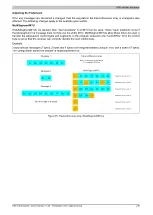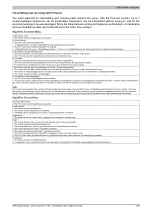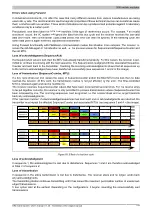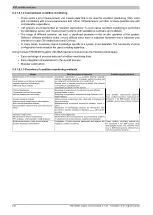
X90 mobile modules
X90 mobile system User's manual V 1.20 - Translation of the original manual
233
5.4.1.6.2 Oscillation measurement technology
5.4.1.6.2.1 Sensor technology
Oscillation sensors convert the mechanical oscillations of the machines being monitored into electrical signals.
For the most part, structure-borne sound, i.e. the sound that spreads through a solid object, is measured.
The acceleration measured within the scope of the condition monitoring is typically measured with piezoelectric
sensors. The oscillation sensors being used utilize the piezoelectric properties of quartz or certain ceramics. The
actual measured value is a force that is proportional to the acceleration.
The piezoelectric effect involves a charge separation when a force acts on the piezoelectric material. This is in
proportion to the force and is consequently proportional to the acceleration. Piezoelectric quartz or piezoelectric
ceramic is used as the piezoelectric material. The output signal is an electrical charge that is specified in pC
(picocoulombs). A charging amplifier is necessary in order to convert the charge into a voltage signal.
The
I
ntegrated
E
lectronics
P
iezo
E
lectric (IEPE) technology used in B&R sensors strengthens the signal directly
in the sensor and emits it as a low-resistance voltage signal. Sensor sensitivity is specified in mV/g.
1 g = 9.81 m/s
2
(gravitational acceleration)
Information:
Piezoelectric sensors cannot measure static magnitudes.
Basic design
In a compression sensor, the piezoelectric crystal is held between a seismic mass and the base of the sensor.
Through the acceleration that occurs, the force acting upon the crystal increases or decreases. The larger the
seismic mass, the larger the output signal.
Sensors of this design can be built with a very high stiffness and thus have a correspondingly high resonance
frequency.
Influencing variables on the sensor
Mounting direction - Preferred direction
Oscillation sensors can be fitted at any location. The installation position usually results from the measuring task
itself. Nevertheless, vibration sensors have a preferred measuring direction. This is normally marked on the sensor
housing.
Oscillations perpendicular to the installation position also act upon the sensor. These can be compensated as
much as possible through appropriate constructive measures and suitable selection of the piezoelectric crystal.
Installation position
B&R vibration sensor 0ACS100A.00-1 is designed for measurements in the longitudinal axis; sensor
0ACS100A.90-1 is designed for measurements in the transverse axis.
0ACS100A.00-1
0ACS100A.90-1
















































